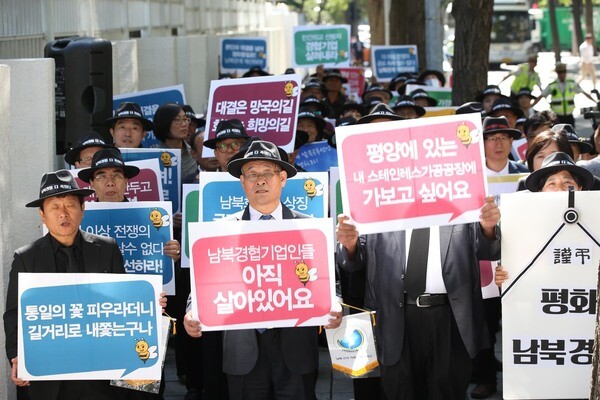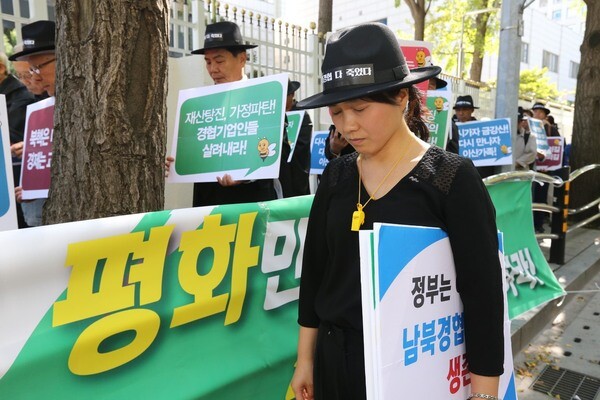hankyoreh
Links to other country sites 다른 나라 사이트 링크
Inter-Korean businesspeople protest for their “right to life”

Around 11:30 am on Oct. 4, which was the ninth anniversary of the signing of the Oct. 4 Inter-Korean Summit Agreement (in full, the Oct. 4 Statement for the Development of Inter-Korean Relations and for Peace and Prosperity), more than a hundred people gathered in front of the rear entrance to the Central Government Complex in Seoul. Most of them were dressed in black, while wearing black hats. In white and red letters on the front and backs of the hats was written, “Inter-Korean economic cooperation is dead” and “Save the businesspeople involved in economic cooperation.”
Inter-Korean relations were at their peak around the Oct. 4 Inter-Korean Summit Agreement, but they rapidly chilled after Lee Myung-bak became president in Feb. 2008. The same fate befell inter-Korean economic cooperation. Tourism to Mt. Keumkang in North Korea was halted after Park Wang-ja, a South Korean tourist to the mountain, was shot and killed by a North Korean patrolman on July 11, 2008. Immediately after the sinking of South Korea’s Cheonan warship on Mar. 26, 2010, Seoul issued a moratorium on all inter-Korean commerce, called the May 24 Measures.
And thus time passed. This is why businesspeople who had led inter-Korean economic cooperation dressed in funeral garb and held this demonstration under a banner that said, “A great march of peace for improving inter-Korean relations and guaranteeing the ‘right to life’ of companies involved in economic cooperation.”
“We were proud of the work we did. Our path was closed in a single day, but we have waited patiently with the belief that someday it would open again. Nearly nine years have gone by, and part of my life is gone,” said Shin Yang-su, chairman of the Association of Businesspeople at Mt. Keumkang, during the rally.
“The situation is such that we can no longer expect anything from inter-Korean relations. The government needs to stop ignoring us and to provide us relief so that businesspeople involved in economic cooperation can get on with their lives,” Shin said. According to the association, which is composed of 49 companies that had been doing business at the tourism complex near Mt. Keumkang, member companies have suffered around 800 billion won in sales losses thus far.
“Until the Kaesong Industrial Complex was closed, our objective was not compensation but rather the resumption of economic cooperation. But now the situation is different. Since economic cooperation has been blocked by government policy just like the Kaesong Complex, we should receive compensation on the same level as the tenant companies at the complex,” said Yu Dong-ho, chair of the Emergency Action Committee for Companies Involved in Inter-Korean Economic Cooperation, an organization of 1,146 companies from the Kaesong Industrial Complex and other areas.
According to a study conducted in Nov. 2014 by the Hyundai Research Institute, the direct losses inflicted on such companies by the May 24 Measures amounted to US$14.59 billion between 2010 and 2013 alone.
At the demonstration on Oct. 4, some younger people in black garb stood out from among the protestors: these were the children of the businesspeople involved in economic cooperation. “Waiting is not hope,” said Lee Sang-yeong, 34, who explained that his father had run a food truck called “The Golden Carriage” at tourist sites around Mt. Keumkang.
“When the tours to Mt. Keumkang were shut down abruptly, we were basically kicked out and didn’t even have a chance to get our stuff. Since leaving the complex, my parents were gradually worn down by hopeless waiting. That waiting broke them. My mother died, and my father had a stroke,” Lee said, as tears reddened his eyes.
On Oct. 4, the businesspeople set up a tent in front of the government complex in Seoul and launched a 100-day overnight demonstration calling on the government to guarantee their “right to life.”
Off to one side of the demonstration, Lim Jin-seok, 56, was holding up a placard and carrying out a one-person protest. Lim is the president of Samwoo Distribution, which supplied food to the Kaesong Complex, and he is the chairman of the Emergency Action Committee of Contractors at the Kaesong Complex, which represents 65 companies that provided logistical, construction and other services to the Kaesong Complex.
“Unlike the tenant companies at the Kaesong Complex, the contractors there were not even informed in advance that the complex was going to be shut down. We were unable to even get our hands on various documents and balance sheets, let alone the items we had in stock, and we haven‘t been compensated yet,” Lim said. On Oct. 4, the Emergency Action Committee of Contractors at the Kaesong Complex started one-person protests in front of the Blue House and at the rear entrance to the government complex to demand that their “right to life” be guaranteed.

By Jung In-hwan, staff reporter
Please direct questions or comments to [english@hani.co.kr]

Editorial・opinion
![[Column] Has Korea, too, crossed the Rubicon on China? [Column] Has Korea, too, crossed the Rubicon on China?](https://flexible.img.hani.co.kr/flexible/normal/500/300/imgdb/original/2024/0419/9317135153409185.jpg) [Column] Has Korea, too, crossed the Rubicon on China?
[Column] Has Korea, too, crossed the Rubicon on China?![[Correspondent’s column] In Japan’s alliance with US, echoes of its past alliances with UK [Correspondent’s column] In Japan’s alliance with US, echoes of its past alliances with UK](https://flexible.img.hani.co.kr/flexible/normal/500/300/imgdb/original/2024/0419/2317135166563519.jpg) [Correspondent’s column] In Japan’s alliance with US, echoes of its past alliances with UK
[Correspondent’s column] In Japan’s alliance with US, echoes of its past alliances with UK- [Editorial] Does Yoon think the Korean public is wrong?
- [Editorial] As it bolsters its alliance with US, Japan must be accountable for past
- [Guest essay] Amending the Constitution is Yoon’s key to leaving office in public’s good graces
- [Editorial] 10 years on, lessons of Sewol tragedy must never be forgotten
- [Column] A death blow to Korea’s prosecutor politics
- [Correspondent’s column] The US and the end of Japanese pacifism
- [Guest essay] How Korea turned its trainee doctors into monsters
- [Guest essay] As someone who helped forge Seoul-Moscow ties, their status today troubles me
Most viewed articles
- 1[Column] The clock is ticking for Korea’s first lady
- 2After 2 months of delayed, denied medical care, Koreans worry worst may be yet to come
- 3[Column] Has Korea, too, crossed the Rubicon on China?
- 4Samsung barricades office as unionized workers strike for better conditions
- 5All eyes on Xiaomi after it pulls off EV that Apple couldn’t
- 6[Correspondent’s column] In Japan’s alliance with US, echoes of its past alliances with UK
- 7US overtakes China as Korea’s top export market, prompting trade sanction jitters
- 8Hong Se-hwa, voice for tolerance whose memoir of exile touched a chord, dies at 76
- 9[Photo] Smile ambassador, you’re on camera
- 10[Editorial] When the choice is kids or career, Korea will never overcome birth rate woes